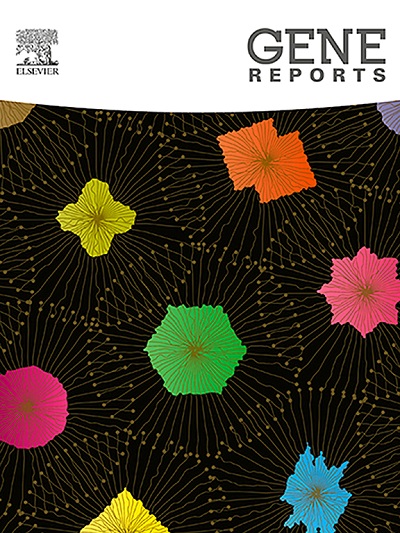Hippo-YAP通路中的关键基因:对宫颈癌的影响
IF 0.9
Q4 GENETICS & HEREDITY
引用次数: 0
摘要
全球癌症相关死亡的主要原因之一是宫颈癌,它具有许多与其病理生理相关的分子机制,包括希波- yap信号系统的功能障碍。该途径可以影响重要的生物过程,如细胞生长、分裂和存活。宫颈癌的危险因素包括长期使用口服避孕药、早期性活动、多性伴侣、人乳头瘤病毒感染和宫颈上皮内瘤变。该病的发病机制受EGFR、MYC、CCND1和ERBB2等多种基因调控。Hippo信号通路磷酸化YAP/TAZ,从而抑制致癌潜力。该通路的失调通过YAP/TAZ激活与预后不良、淋巴结转移和早期宫颈癌有关。转录组学、单细胞基因组分析和多组学整合等测序技术的进步也为这一途径提供了线索,为更好的治疗奠定了基础。高接种率的hpv疫苗接种和密集的筛查计划对于降低宫颈癌发病率和减少死亡至关重要。本文通过Hippo-YAP通路分析了宫颈癌的致病基因和基因表达谱,并对其病理生理、进展和耐药进行了全面的讨论。本文章由计算机程序翻译,如有差异,请以英文原文为准。
Key genes in the Hippo-YAP pathway: Implications for cervical cancer
One of the leading causes of cancer-related deaths globally is cervical cancer, which has many molecular mechanisms associated with its pathophysiology, including the dysfunction of the Hippo-YAP signalling system. The route can affect important biological processes such as cell growth, division, and survival. Risk factors for cervical cancer include long-term use of oral contraceptives, early sexual activity, multiple sexual partners, human papillomavirus infection, and cervical intraepithelial neoplasia. The disease mechanisms are regulated by many genes such as EGFR, MYC, CCND1, and ERBB2. The Hippo signalling pathway phosphorylates YAP/TAZ, thereby inhibiting carcinogenic potential. Dysregulation of the pathway has been linked with poor prognosis, lymph node metastasis, and cervical carcinoma in the early stage through YAP/TAZ activation. Progress in sequencing technologies, such as transcriptomics, single-cell genomic profiling, and multi-omics integration, has also shed light on this pathway for setting the foundation for better treatment. Vaccination against HPVs with high rates and intensive screening programs are critical for reducing cervical cancer incidence and death reduction. This review analyzed cervical cancer pathogenic genes and gene expression profiles by the Hippo-YAP pathway, with a comprehensive discussion of pathophysiology, progression, and drug resistance.
求助全文
通过发布文献求助,成功后即可免费获取论文全文。
去求助
来源期刊

Gene Reports
Biochemistry, Genetics and Molecular Biology-Genetics
CiteScore
3.30
自引率
7.70%
发文量
246
审稿时长
49 days
期刊介绍:
Gene Reports publishes papers that focus on the regulation, expression, function and evolution of genes in all biological contexts, including all prokaryotic and eukaryotic organisms, as well as viruses. Gene Reports strives to be a very diverse journal and topics in all fields will be considered for publication. Although not limited to the following, some general topics include: DNA Organization, Replication & Evolution -Focus on genomic DNA (chromosomal organization, comparative genomics, DNA replication, DNA repair, mobile DNA, mitochondrial DNA, chloroplast DNA). Expression & Function - Focus on functional RNAs (microRNAs, tRNAs, rRNAs, mRNA splicing, alternative polyadenylation) Regulation - Focus on processes that mediate gene-read out (epigenetics, chromatin, histone code, transcription, translation, protein degradation). Cell Signaling - Focus on mechanisms that control information flow into the nucleus to control gene expression (kinase and phosphatase pathways controlled by extra-cellular ligands, Wnt, Notch, TGFbeta/BMPs, FGFs, IGFs etc.) Profiling of gene expression and genetic variation - Focus on high throughput approaches (e.g., DeepSeq, ChIP-Seq, Affymetrix microarrays, proteomics) that define gene regulatory circuitry, molecular pathways and protein/protein networks. Genetics - Focus on development in model organisms (e.g., mouse, frog, fruit fly, worm), human genetic variation, population genetics, as well as agricultural and veterinary genetics. Molecular Pathology & Regenerative Medicine - Focus on the deregulation of molecular processes in human diseases and mechanisms supporting regeneration of tissues through pluripotent or multipotent stem cells.
 求助内容:
求助内容: 应助结果提醒方式:
应助结果提醒方式:


